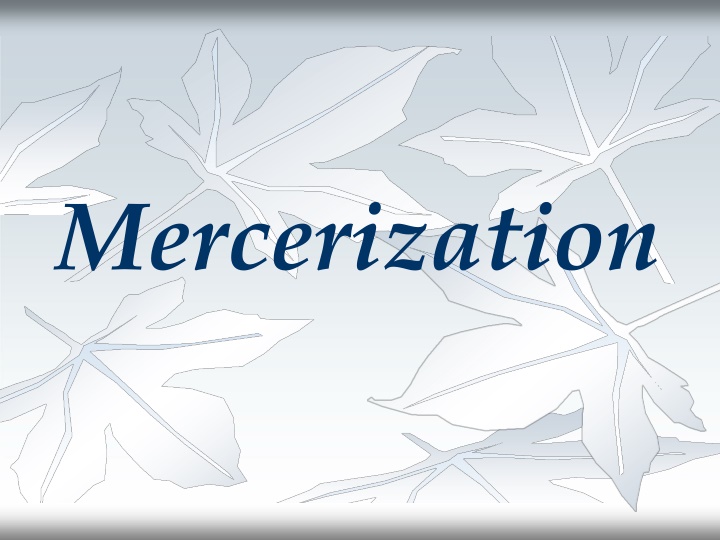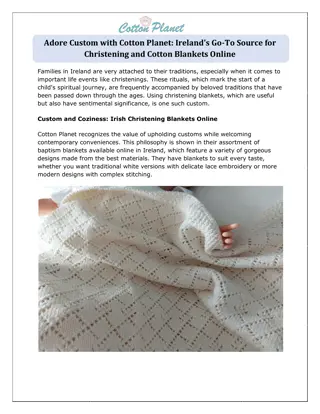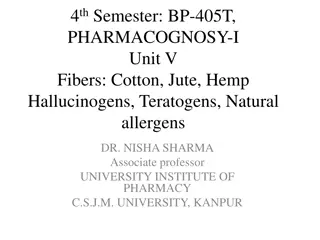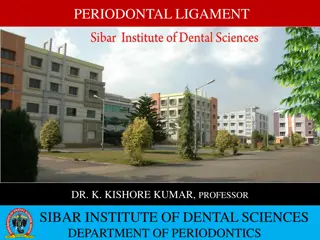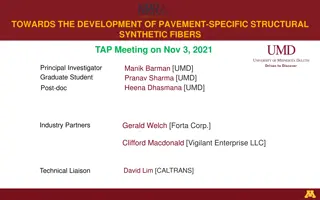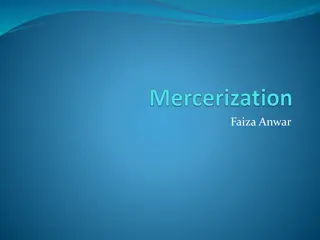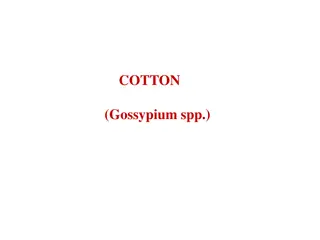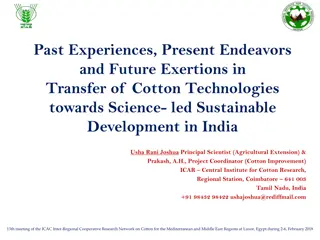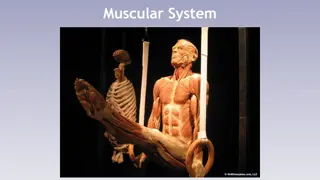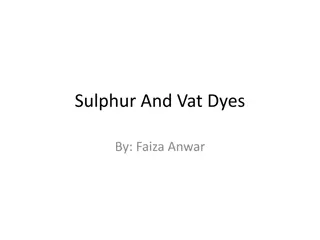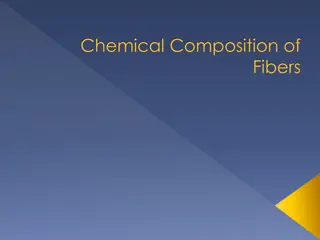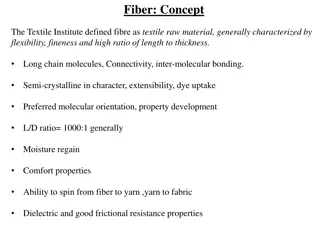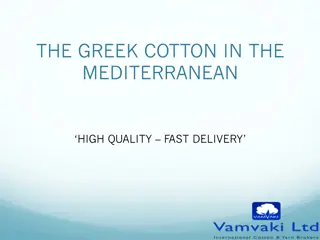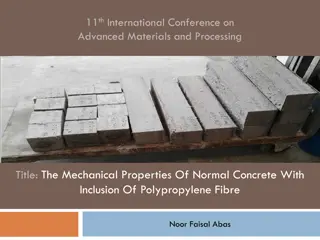Mercerization: Transforming Cotton Fibers
Mercerization is a chemical treatment method primarily used on cotton fibers to enhance their strength, luster, and absorbency. The process involves treating the fabric with a concentrated solution of Sodium Hydroxide, resulting in various improvements such as increased dye absorption, enhanced stability, and smoother texture. Mercerization not only alters the physical properties of cotton fibers but also enhances their overall quality and appearance.
Download Presentation

Please find below an Image/Link to download the presentation.
The content on the website is provided AS IS for your information and personal use only. It may not be sold, licensed, or shared on other websites without obtaining consent from the author.If you encounter any issues during the download, it is possible that the publisher has removed the file from their server.
You are allowed to download the files provided on this website for personal or commercial use, subject to the condition that they are used lawfully. All files are the property of their respective owners.
The content on the website is provided AS IS for your information and personal use only. It may not be sold, licensed, or shared on other websites without obtaining consent from the author.
E N D
Presentation Transcript
Mercerization is a treatment for cellulosic materials, typically cotton, that strengthens them and gives them a lustrous appearance. It is a process in which the fabric is treated with cold concentrated solution of Sodium Hydroxide (NaOH). The process essentially consist of impregnation of cotton fabric in NaOH solution 25-35% strength for 30- seconds at temperature of 18-30 C. 60
Objectives of mercerization: To improved lustre (shiny). To increased ability to absorb dye and moisture regain. To improved reactions with a variety of chemicals. To improved strength/elongation. To improved smoothness and hand feel. To improved stability of yarn form.
PROCESS SEQUENCES OF CHEMICAL PROCESSING Grey fabric Singeing Desizing Bleaching Drying Scouring Mercerising Dyeing Printing Soaping & Drying Folding & Packing Finishing
Introduction to mercerization: Mercerization was found by John Mercer in 1844 of England, who treated cotton fibers withNaOH. )sometimes NH3, LiOH or KOH being used( The process did Horace. A. Loweimproved it into its modern form in 1890 Byholdingthecottonduringtreatmentto prevent it from shrinking, Horace Lowe foundthat the fibre gained a lustrousappearance. In the process of mercerization four factors are considered: NaOH conc., time, temperature and tension. not become popular until
This mercerization is applicable only on cellulosic fibres The main purpose of mercerization is to alter the chemical and physical properties of thefibre. cotton is held under specified tension for about 30 to 60 seconds with an application of between 25%-35% caustic soda (NaOH) and wetting agents (used to facilitate the transfer of the NaOH into the fibers), at 18-30 C temperature. Then the fabric is neutralized in an acid bath. Caustic soda solution swells cotton fibers breaking hydrogen bonds and weak van der Waal forces between cellulose chains.
The expanded, chains rearrange and re-orient and when the caustic soda is removed , the chains form new bonds in the reorganized state. When done tensionless, the cotton fiber swells, the cross section becomes thicker and the length is shortened. the fabric becomes denser, stronger and more elastic. Under tension, The fibers become round and rod like in cross section and the fiber surface is smoother, adding to fiber luster.
Mercerization types : 1. Full-mercerization NaOH 28 - 32% T 18OC 2. Semi-mercerization NaOH 13 - 15%
Conditions of Mercerization 1- Impregnation in NaOH for 50-60 s at 18OC or less. 2- Cloth must be desizing, so NaOH can penetrate. 3- Addition of some wetting and penetrating agents. 4- Good tension of the cloth to its original dimensions until washed , where the remaining NaOH on fiber must be around 7% only. 5- Avoiding any creases in the cloth. 6- Good adjustment of soda concentration used. 7- Good washing and neutralization with acid.
Mercerization is possible -after desizing -after desizing and scouring -after bleaching Mercerization methods: 1. Slack Mercerization (treatment withouttension) e.g. mercerization with NH3 2. Tension Mercerization (treatment under tension) e.g. mercerization with causticsoda.
1- Ammonia Mercerization (SlackMercerization): In this process ammonia is penetrate in the fiber & effect the crystalline and amorphous region of the fiber and swell them. Aqueous ammonia can only be disposed off by shipment to fertilizer plants or other non-textile process that can use this liquid, or, it must be recovered in an expensive distillation process for further reuse. liquid ammoniatreatment is not so popular.
Advantages of Liquid AmmoniaMercerization: Improved strength (up to 90%) Enhance luster Better dye ability Stability to laundering and greater thermal resistance
Why liquid ammoniatreatment is not so popular : To keep liquid ammonia in liquid form it must stored below 33OC. It forms explosive moisture with air When leakage in machine it is highly affected to workers.
2-NaOH Mercerization (Tension Mercerization): Procedures: Dipped cotton fabric into a strong and cold alkaline solution such as lithium hydroxide, caustic soda, or potassium hydroxide. The fibers will swell and shrinkwhile still impregnated in the caustic solution. They are placed under tension whilein this swollen state and then rinsed withwater. The alkali will be removed and a permanent round rod and silk-like luster willresult.
Physical Change: Breaking of old bond Effect of strong caustic soda (Fiber swollen). Improved in strength. Improved in lusture (under tension). Change in cross section circular shape. Swell and opening of fibre structure. New bonds are formed upon washing off NaOH. Increase in the number of OH group. from bean shape to
Chemical change: Improvement in moisture regain. Improvement in dye uptake. On washing and neutralization; the native cellulose I with concentration of NaOH formed cellulose II.
Change in cross section: 1. Cross section of cotton beforemercerisation 2 -5. swelling process in 18% NaOH 6. Rinsing process after swelling 7. Final state
Advantages ofMercerizing The mercerized fibers were able to absorb more water, and therefore absorb more dye. colour of the dyed cloth is brighter and deeper. it also gives the cloth a better resistance to multiple washings, keeping the colours bright and unchanged overtime. Mercerization treatment increases strength, smoothness, and also reduces lint (protruding). It also increases luster and affinity to dyestuffs.
Types of mercerizationsinstrumentations: 1. Chainless mercerization: This method is also called roller mercerization. The machine has a number of stainless rollers and rubber rollers, of a relatively-largediameter tiered zigzag in close contact to each other inside a long trough, with the lower tier designed to submerge in alkaline solution for mercerization. This type is bound to limited length of fabric. Following this initial stage of alkali penetration and fabric swelling, a similar device is used for the removal of most alkaliand a soaping machine for further removal andneutralization.
2. Chain mercerization A clip stenter is used for post-mercerization treatment, in which a width wise tension is applied then most alkali is showered off the fabric kept on the stenter, followed by thorough alkali removal and neutralization using an open- width washing machine. A heavy padding mangle is used for the application of alkaline solution in the 2 dip/2 nip method, with sufficient time allowed for penetration and swelling of the fabric in a timing cylinder, instead of undergoing an operation using so many rollers and so much solution as in roller mercerization, to ensure reduced use of thealkali.
